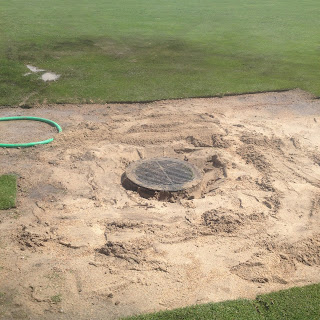Not a whole lot new on the golf course as of late so here are some random musings to entertain your thoughts in the middle of winter.
Wild Horse has been blanketed with snow for over a week now which is a plus for our turf. In addition it has received a couple of rains. Rain in December and January in Nebraska? Another sign of global warming? Maybe, maybe not, but it seems clear that the earth is warming considering the last few years' record temperatures. How much man's influence is having on the weather is up for debate but most impartial observers would concur that the past few years have been extremely warm worldwide. Perhaps the ice storms so prevalent in Oklahoma and Kansas will become more abundant here in Nebraska. Lets hope not! but at least last week's storm moved on quickly and the moisture was good for the turf.
Winter is Conference and Show time for the turf professional and I recently attended the Nebraska Turfgrass Conference. After you have been to these for 20+ years it is hard to come up with much new on the turf front but each session provokes evaluation of our current program and how we might improve it. Many times though the most interesting sessions cover subjects other than turf but are relevant to our profession. Here are some of the most interesting tidbits from those sessions:
In a session about retirement I learned about distributing your retirement income efficiently. Most retirement discussions focus on building wealth for retirement but this was different. How will you distribute that wealth once you retire?
There are no native earthworms anymore. They have all been replaced by European species that have naturalized here.
One of our commonly used insecticides for grubs (imidacloprid) is 1/2 as toxic as caffeine. Most chemicals get a bad rap but are really very safe!
A TV meteorologist provided insight into forecasting. For those of you who have a keen interest in weather google Bering Sea Rule and North Atlantic Oscillation Index which can provide clues for our weather here in the northern plains up to 2 weeks in advance.
The beetles are coming! The beetles are coming!! Emerald ash borers are now in Nebraska and will probably move west endangering all ash trees. You may have seen this in the news and it will have a very damaging impact on our landscape.
Growing degree day models are becoming more important to turf managers for plant growth regulator applications, insect issues and disease prediction. We have used these for awhile and modeling is becoming better at pinpointing application schedules. Timing in turf management as in life is everything!
The University of Nebraska-Lincoln continues to be a strong turf research school and just built a new research facility on east campus. It also is developing students for the real world through a rigorous internship program. I'm proud to be a graduate of such a highly regarded program!
Golf architecture is heavily influenced by a superintendent's work. How a course is presented greatly influences the design intent of each hole.
These are just a few of the various ideas presented during the conference. Many did not have to do with turf management directly but golf course management is much more than just turf. Many disciplines play a significant role in my job here at Wild Horse. Hope these tidbits got you to thinking about anything! Thinking is good!
























